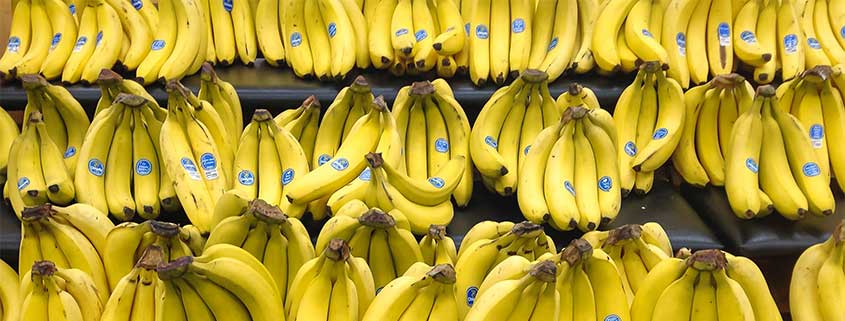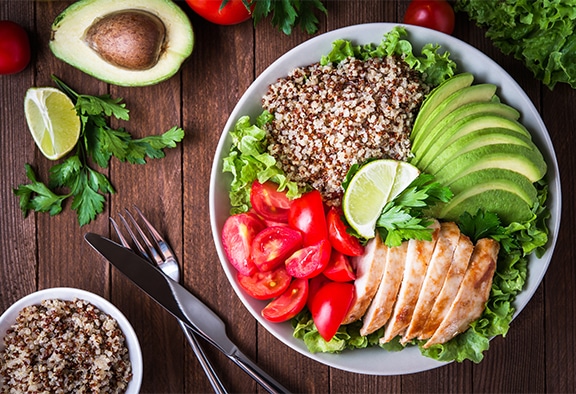
If you have diabetes, you know how important it is to manage your blood pressure. Along with cutting back on salt, what you might not know is how potassium-rich foods can help.

Written by: ADS Staff
Clinically Reviewed by: Halle Elbling, MS, RDN, CDCES
While the early symptoms of diabetes are difficult enough on their own, the complications are what many people with this disease really dread. If you don’t take steps to control your diabetes, you could face an increased risk of significant health problems in the future.
One commonly-overlooked factor contributing to some diabetes complications is blood pressure. If your blood pressure is elevated or high, it’s a good idea to start getting it under control – and one of the best steps you can take towards this goal is also one of the simplest. Read on for more about the link between potassium and diabetes and navigating the effects of high blood pressure.
Blood Pressure and Diabetes
While it’s always necessary to keep your blood pressure from getting too high, people living with diabetes have even more of a reason to keep this in mind. Some of the most dangerous complications of diabetes, including kidney disease and eye damage, have direct links to high blood pressure. Since high blood pressure doesn’t usually have symptoms, regular blood pressure tests are essential if you have diabetes.
Unfortunately, the connection between diabetes and high blood pressure works both ways. That means having diabetes can increase your likelihood of having elevated blood pressure – the disease can damage and harden your arteries. And high blood pressure comes with problems of its own, like heightened levels of heart disease, stroke, and vascular disease.
The Benefits of Potassium Rich Foods For Diabetes

Having high blood pressure is common for people with diabetes, but that doesn’t mean you have to give up! Small lifestyle changes can make a big difference. In fact, increasing your potassium intake is a great place to start, as there’s a correlation between potassium and diabetes management.
The reason potassium is so great at improving your heart health is its ability to counteract sodium. When you eat foods containing potassium, part of the sodium in your system will get excreted in your urine as a result. And potassium’s benefits don’t stop there – it can reduce tension in the walls of your blood vessels, too.
Most adults with blood pressure higher than 120/80 can benefit from extra potassium in their diets. If you have kidney disease, have conditions affecting how your body responds to potassium, or take certain medications, it may do more harm than good. To stay safe, be sure to talk to your doctor or healthcare team before making any dietary changes.
Examples of Potassium Rich Foods
If you’ve gotten the all-clear from your health professionals, it’s time to look at ways to boost your potassium intake. On average women need about 2600 mg of potassium a day and men need 3400 mg per day. Many Americans do not get enough potassium in their diets. For example, bananas are famously high in potassium – a single medium-sized banana is packed with a whopping 420 mg of this mineral. And while they’re relatively high in sugar content, bananas also contain fiber, and can be a healthy option for many people with diabetes.
Of course, bananas aren’t the only food containing potassium. Additional potassium sources worth your consideration include:
- Potatoes and sweet potatoes
- Fat-free dairy products, like yogurt
- Oranges
- Spinach, broccoli and other leafy greens
- Mushrooms
- Beans like black, lima, pinto, kidney and soybeans
- Cantaloupe/honeydew melon
- Tomatoes
- Nuts
- Avocadoes
- Zucchini
- Tuna, Halibut and Cod
- Canned salmon
Again, it’s crucial to remember that some of these foods contain relatively high levels of carbs. Because of this, consider working with a Registered Dietitian to understand your personal potassium and diabetes management strategy.
Potassium and Diabetes – Is the Dash Diet an Option?
For people who have hypertension, following an overall eating plan called DASH (Dietary Approaches to Stop Hypertension) may also be useful for lowering blood pressure. The DASH diet is rich in fruits, vegetables, low-fat and nonfat dairy, and includes whole grains, nuts/beans/seeds, lean meats, fish, poultry, and heart healthy fats. The DASH diet is higher in potassium, magnesium, and calcium and lower in total fat, saturated fat, added sugars and sodium than what is usually in the typical American diet. Some examples of a DASH meal plan are:
- For breakfast a serving of oatmeal and light yogurt or whole grain cereal with fresh fruit.
- For lunch a green salad with lots of vegetables, lean protein and fresh fruit.
- For dinner some baked fish, asparagus, a whole wheat roll and low fat milk.
- Snack examples include light string cheese, fresh fruit or a handful of unsalted almonds.
Some individuals may need to restrict their dietary potassium intake due to certain illnesses. Having too much or too little potassium in the body can have very serious consequences. The kidneys regulate the level of potassium in the body. Having low potassium levels or hypokalemia is uncommon in people who eat a healthy diet. But potassium deficiency may result from excessive potassium losses due to severe vomiting or diarrhea, poor diabetic control, very low-calorie diets for example less than 800 calories per day, chronic alcoholism, hard exercise, or due to some diuretics and laxatives. If you take certain diuretics, you may need more or less potassium. Ask your physician about the type of diuretic drug you take and whether you require additional potassium for example a prescribed potassium supplement to help replace potassium loss.

Other Ways To Lower Your Blood Pressure
Boosting your potassium intake can be a highly effective way to lower your blood pressure – but it works best when you’re taking other steps towards this goal, too. Along with making dietary changes, consider:
- Getting moderate amounts of physical activity most days of the week
- Avoiding excessive alcohol
- Cutting out smoking (if you currently smoke)
- Visiting your doctor and healthcare team regularly
- Making an effort to track your blood sugar closely
Cut Down On Stress With ADS
Making changes to your diet to increase your potassium intake shouldn’t be too hard. However, this is just one of the steps people with diabetes should take – and when you’re taking care of lots of other things, even the most minor adjustment can feel challenging. Because of this, it’s a good idea to avoid stress where you can.
Have you ever thought about the stress that comes with buying diabetes supplies? Whether you use insulin, glucose meters, or other supplies, you likely have to pay close attention to ensure you’re not at risk of running out of the items you need. Choosing a world-class online diabetes supply company like ADS can make this process easier – get started by checking out our complete selection of diabetes management products!
